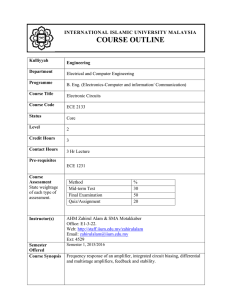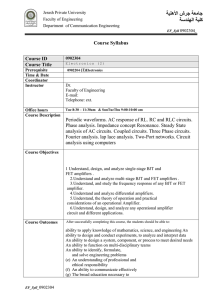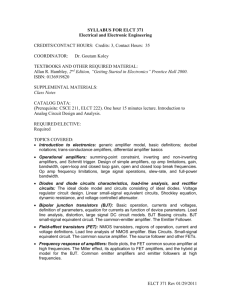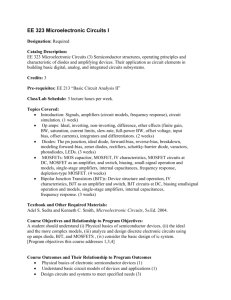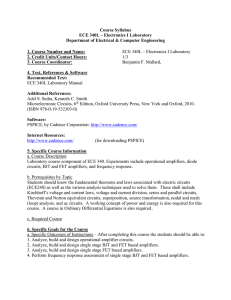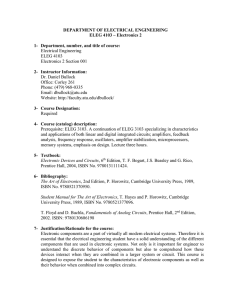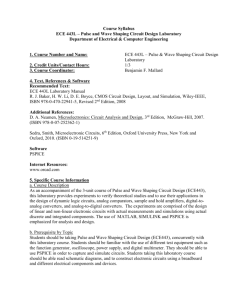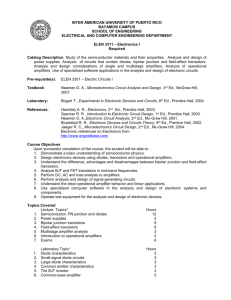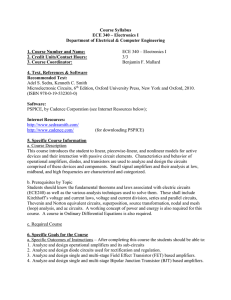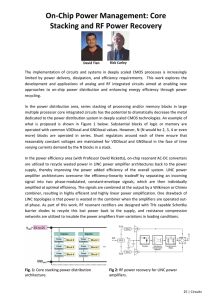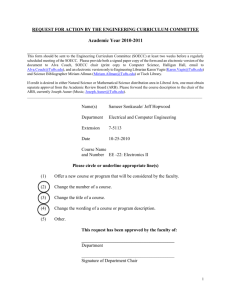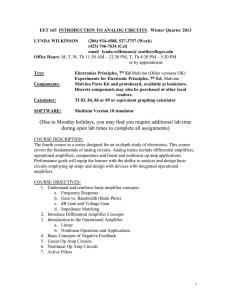Course Outline - International Islamic University Malaysia
advertisement
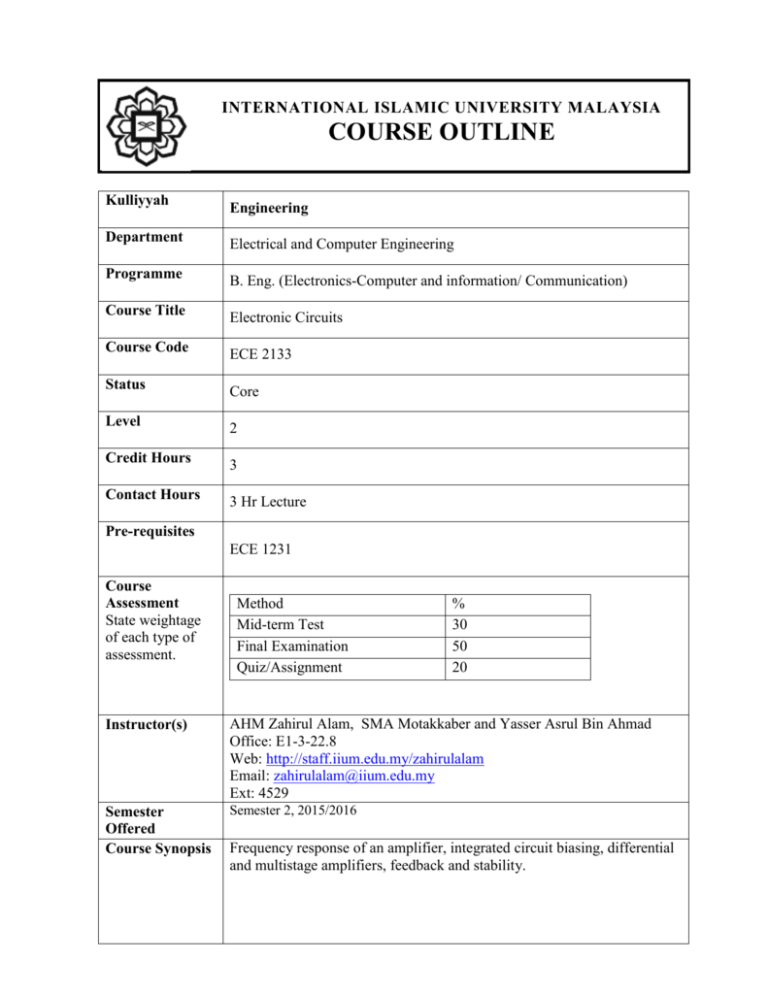
INTERNATIONAL ISLAMIC UNIVERSITY MALAYSIA COURSE OUTLINE Kulliyyah Engineering Department Electrical and Computer Engineering Programme B. Eng. (Electronics-Computer and information/ Communication) Course Title Electronic Circuits Course Code ECE 2133 Status Core Level 2 Credit Hours 3 Contact Hours 3 Hr Lecture Pre-requisites ECE 1231 Course Assessment State weightage of each type of assessment. Method Mid-term Test Final Examination Quiz/Assignment % 30 50 20 Instructor(s) AHM Zahirul Alam, SMA Motakkaber and Yasser Asrul Bin Ahmad Office: E1-3-22.8 Web: http://staff.iium.edu.my/zahirulalam Email: zahirulalam@iium.edu.my Ext: 4529 Semester Offered Course Synopsis Semester 2, 2015/2016 Frequency response of an amplifier, integrated circuit biasing, differential and multistage amplifiers, feedback and stability. Course Objectives Learning outcomes The objectives of this course are to: 1. Analysis frequency response of an amplifier 2. Design an amplifier circuit. 3. Design of an integrated circuit biasing circuits 4. Study the feedback topologies. Upon completion of this course the students should be able to: 1. Analyze low frequency responses of amplifiers. 2. Analyze high frequency responses of amplifiers. 3. Analyze integrated electronic circuits quantitatively. 4. Analyze negative feedback amplifiers. 5. Analyze differential amplifiers. Content Outlines Weeks Topics Task/Reading 1-3 Frequency response: Low and high frequency response of Chapter 7 bipolar transistor and FET amplifier circuits. 4-5 Coupling and Load capacitances effects on frequency Chapter 7 response of the amplifier. 6-7 Internal capacitance effects on frequency response of the Chapter 7 amplifier. Midterm : Thursday 17th March 2016; 8:00pm-10:pm 8-9 Integrated Circuit biasing: BJT and FET current sources, Chapter 10 small signal analysis of the circuits. 10-12 Feedback and Stability: Basic concepts of feedbacks, Chapter 12 feedback topologies, different types of feedback networks, loop gains, stability of feedback circuits, frequency compensation. 13-14 Differential amplifiers: Basic BJT and FET differential pairs, Chapter 11 gain stage and simplified output stage, simplified BJT OpAmp circuit, Diff-Amp frequency response. References Required Neamen, D. A., (2010). Microelectronics: Circuit Analysis and Design. McGraw Hill. Recommended Jaeger, R.C. & Blalock T. N., (2004). Microelectronic Circuit Design. McGraw Hill. Rashid, M. H., (1999). Microelectronic circuits - Analysis and Design. PWS Publishing. Sedra, A. S. & Smith, K. C., (2004). Microelectronic Circuits. Oxford University Press. Learning Outcomes Matrix: ECE 1311/ Electric Circuits LO1. Analyze low frequency responses of amplifiers LO2. Analyze high frequency responses of amplifiers LO3. Analyze integrated electronic circuits quantitatively. x x x x x LO4. Analyze negative feedback amplifiers. x x x x LO5. Analyze differential amplifiers. x x x * 1= objective addresses outcome slightly, 2= x moderately, 3= substantive Outcome 12 Outcome 11 Outcome 10 Outcome 9 Outcome 8 Outcome 7 Outcome 6 Outcome 5 Outcome 4 Outcome 3 Outcome 2 Course Learning Outcomes Outcome 1 Programme Outcomes KOE PO 1. Engineering Knowledge (T) -Apply knowledge of mathematics, sciences, engineering fundamentals and an engineering specialization to the solution of complex engineering problems; 2. Problem Analysis (T) – Identify, formulate, research relevant literature and analyze complex engineering problems, and reaching substantiated conclusions using first principles of mathematics, natural sciences and engineering sciences; 3. Design/Development of Solutions (A) –Design solutions, exhibiting innovativeness, for complex engineering problems and design systems, components or processes that meet specified needs with appropriate consideration for public health and safety, cultural, societal, economical, ethical, environmental and sustainability issues. 4. Investigation (D) Conduct investigation into complex problems, displaying creativeness, using research-based knowledge, and research methods including design of experiments, analysis and interpretation of data, and synthesis of information to provide valid conclusions; 5. Modern Tool Usage (A & D) -Create, select and apply appropriate techniques, resources, and modern engineering and IT tools, including prediction and modelling, to complex engineering activities, with an understanding of the limitations; 6. The Engineer and Society (ESSE) -Apply reasoning based on contextual knowledge to assess societal, health, safety, legal, cultural, contemporary issues, and the consequent responsibilities relevant to professional engineering practices. 7. Environment and Sustainability (ESSE) -Understand the impact of professional engineering solutions in societal, global, and environmental contexts and demonstrate knowledge of and need for sustainable development; 8. Ethics (ESSE) –Apply professional ethics with Islamic values and commit to responsibilities and norms of professional engineering code of practices. 9. Communication (S) -Communicate effectively on complex engineering activities with the engineering community and with society at large, such as being able to comprehend and write effective reports and design documentation, make effective presentations, and give and receive clear instructions; 10. Individual and Team Work (S) -Function effectively as an individual, and as a member or leader in diverse teams and in multi-disciplinary settings. 11. Life Long Learning (S) -Recognize the need for, and have the preparation and ability to engage in independent and life-long learning in the broadest context of technological change. 12. Project Management and Finance (S) -Demonstrate knowledge and understanding of engineering management and financial principles and apply these to one’s own work, as a member and/or leader in a team, to manage projects in multidisciplinary settings, and identify opportunities of entrepreneurship. MQF Domain 1&6 1&6 2, 3 & 6 2&6 7 3&4 3&4 3&4 5&7 8 7 8
